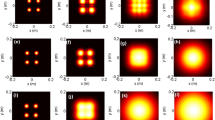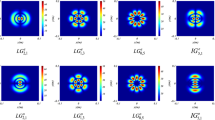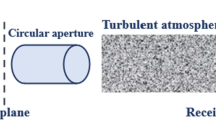Abstract
Beam propagation through a double-adaptive-optics optical system in turbulent atmosphere has been investigated. A typical model of optical systems with the double-adaptive-optics configuration is established, principles of the two adaptive optics and theory of beam propagation through the optical system in turbulent atmosphere are analyzed. Power efficiency and beam quality (BPF) of the received beam are introduced to evaluate performance of the optical system. Under the H-V 5/7 turbulent model, influences of the two adaptive optics installations are numerically calculated, respectively. Results show that the adaptive optics at the launcher can improve both power efficiency and beam quality of the received beam, the adaptive optics at the receiver can significantly improve beam quality of the received beam. Evolution of the system performance with the increase of adaptive optics correction order is numerically simulated, and results show that the double-adaptive-optics configuration has great advantages in improving beam quality of the received beam in optical systems with beam long-distance propagation through the turbulent atmosphere.






Similar content being viewed by others
References
Caplan, D.O.: Laser communication transmitter and receiver design. J. Opt. Fiber Commun. Res. 4, 225–226 (2007)
Chu, X., Liu, Z., Wu, Y.: Propagation of a general multi-Gaussian beams in turbulent atmosphere in a slant path. J. Opt. Soc. Am. A 25, 74–79 (2008)
Chu, X.: Study on the Propagation and Transform of Laser Beams through a Relay Mirror System. National University of Defense Technology, Changsha (2009)
Dipankar, A., Sagaut, P.: A new phase-screen method for electromagnetic wave propagation in turbulent flows using large-eddy simulation. J. Comput. Phys. 228, 7729–7741 (2009)
Duff, E.A., Washburn, D.C.: The magic of relay mirrors. Proc. SPIE 5413, 139–143 (2004)
Mahdieh, M.H.: Numerical approach to laser beam propagation through turbulent atmosphere and evaluation of beam quality factor. Opt. Commun. 281(13), 3395–3402 (2008)
Roddier, N.: Atmospheric wave-front simulation using Zernike polynomial. Opt. Eng. 29, 1174–1180 (1990)
Toselli, I., Andrews, L.C., Phillips, R.L., Ferrero, V.: Free space optical system performance for laser beam propagation through non-Kolmogorov turbulence. Opt. Eng. 47, 026003 (2008)
Tyson, R.K.: Principles of Adaptive Optics, pp. 22–36. Academic Press, Boston (1997)
Vorontsov, M.A., Carhart, G.W.: Adaptive phase-distortion correction based on parallel gradient-descent optimization. Opt. Lett. 22, 907–909 (1997)
Vorontsov, M.A., Sivokon, V.P.: Stochastic parallel-gradient-descent technique for high-resolution wave-front phase-distortion correction. J. Opt. Soc. Am. A 15, 2745–2758 (1998)
Wild, A.J., Hobbs, R.W., Frenje, L.: Modelling complex media: An introduction to the phase-screen method. Phys Earth Planet Interiors 120, 219–225 (2000)
Wu, H.: Study on Beam Propagation and Control Optimization in a Relay Mirror System. National University of Defense Technology, Changsha (2012)
Xiaolin, W.: Study on Optimization Algorithm Based Adaptive Optics in Laser Phased Array. National University of Defense Technology, Changsha (2011)
Yang, P., Ao, M., Liu, Y., Xu, B., Jiang, W.: Intracavity transverse modes controlled by a genetic algorithm based on Zernike mode coefficients. Opt. Express 15, 17051–17062 (2007)
Yang, P., Liu, Y., Ao, M., Hu, S.J., Xu, B.: A wavefront sensor-less adaptive optical system for a solid-state laser. Opt. Laser Eng. 46, 517–521 (2008)
Zhao, Z., Lyke, S.D., Roggemann, M.C.: Adaptive optical communication through turbulent atmospheric channels. IEEE International Conference on Communications pp. 5432–5436 (2008)
Zhong, Y., Cui, Z., Shi, J., Qu, J.: Propagation properties of partially coherent Laguerre-Gaussian beams in turbulent atmosphere. Opt. Laser Technol. 43, 741–747 (2011)
Zhou, P., Liu, Z., Xu, X., Chu, X.: Propagation of phase-locked partially coherent flattened beam array in turbulent atmosphere. Opt. Laser Eng. 47, 1254–1258 (2009)
Zhou, P., Liu, Z., Xu, X., Xi, F., Chu, X., Ma, H.: Propagation performance of adaptive phase-locked fiber laser array in turbulent atmosphere. Chin. J. Lasers 36, 1442–1446 (2009)
Zhou, P., Liu, Z., Xu, X., Chen, Z., Wang, X.: Beam quality factor for coherently combined fiber laser beams. Opt. Laser Technol. 41, 268–271 (2009)
Author information
Authors and Affiliations
Corresponding authors
Rights and permissions
About this article
Cite this article
Wu, H., Sheng, S., Huang, Z. et al. Study on beam propagation through a double-adaptive-optics optical system in turbulent atmosphere. Opt Quant Electron 45, 411–421 (2013). https://doi.org/10.1007/s11082-013-9653-9
Received:
Accepted:
Published:
Issue Date:
DOI: https://doi.org/10.1007/s11082-013-9653-9




